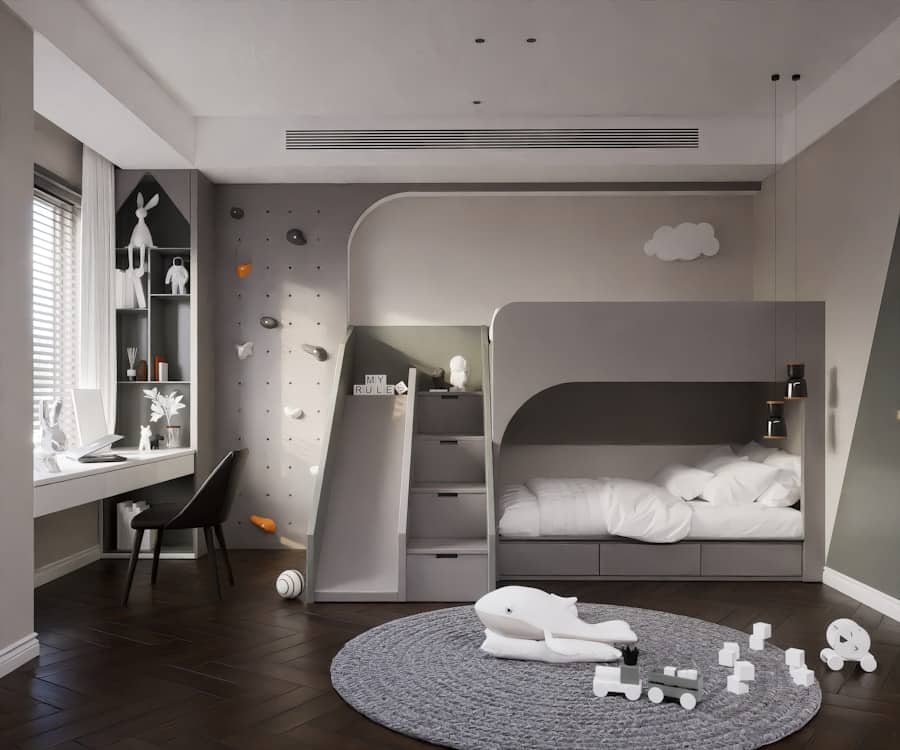In recent years, the evolution of sleep technology has led to the emergence of smart beds, a revolutionary advancement in the realm of sleep solutions. These innovative beds are designed to enhance the quality of sleep through a combination of advanced technology and user-centric features. Unlike traditional mattresses, smart beds integrate various sensors and connectivity options that allow them to monitor and respond to the user’s sleep patterns, preferences, and overall health.
This transformation in sleep technology is not merely a trend; it represents a significant shift in how we approach rest and recovery in our increasingly fast-paced lives. The concept of smart beds extends beyond mere comfort; it encompasses a holistic approach to improving sleep quality and overall well-being. With the rise of health consciousness and the growing awareness of the importance of sleep, smart beds have gained traction among consumers seeking to optimize their nightly rest.
By leveraging data analytics and real-time feedback, these beds can provide insights into sleep habits, enabling users to make informed decisions about their sleep environment. As we delve deeper into the features and benefits of smart beds, it becomes evident that they are not just a luxury but a valuable investment in health and wellness.
Key Takeaways
- Smart beds are revolutionizing the way we sleep by incorporating advanced technology and features to improve sleep quality and overall health.
- Technology and features of smart beds include adjustable firmness, temperature control, sleep tracking, and connectivity to smart devices for personalized sleep experiences.
- Smart beds improve sleep quality by providing optimal support and comfort, reducing pressure points, and minimizing disturbances throughout the night.
- Smart beds can have a positive impact on posture by providing proper spinal alignment and support, which can alleviate back pain and improve overall body alignment.
- Customization and personalization of smart beds allow users to tailor their sleep experience to their specific needs and preferences, promoting better rest and overall well-being.
Technology and Features of Smart Beds
At the heart of smart beds lies an array of cutting-edge technology designed to enhance the sleeping experience. Many models are equipped with adjustable firmness settings, allowing users to customize the feel of their mattress according to personal preference. This feature is often achieved through air chambers or foam layers that can be inflated or deflated at the touch of a button, providing tailored support for different sleeping positions.
Additionally, some smart beds come with built-in heating and cooling systems that regulate temperature throughout the night, ensuring optimal comfort regardless of external conditions. Another notable feature of smart beds is their ability to track sleep metrics. Equipped with sensors that monitor heart rate, breathing patterns, and movement, these beds can provide users with detailed insights into their sleep cycles.
For instance, some models can differentiate between light, deep, and REM sleep stages, offering valuable data that can help users understand their sleep quality better. This information is often accessible via a companion app, which not only displays sleep statistics but also provides personalized recommendations for improving sleep hygiene. The integration of artificial intelligence further enhances these capabilities, as smart beds can learn from user behavior over time and adjust settings automatically for optimal rest.
How Smart Beds Improve Sleep Quality

The primary goal of smart beds is to enhance sleep quality, and they achieve this through various mechanisms.
For example, many smart beds feature adjustable bases that allow users to elevate their heads or feet, which can alleviate issues such as snoring or acid reflux.
By finding the ideal position for each individual, these beds help reduce disturbances during the night, leading to more uninterrupted sleep cycles. Moreover, the data collected by smart beds can be instrumental in identifying sleep disorders or irregularities. Users can track patterns over time and share this information with healthcare professionals if needed.
For instance, if a user consistently experiences restless nights or excessive wakefulness, they can use the insights provided by their smart bed to address these issues proactively. This proactive approach not only improves immediate sleep quality but also contributes to long-term health benefits by reducing the risk of chronic conditions associated with poor sleep.
The Impact of Smart Beds on Posture
Posture during sleep is crucial for overall spinal health and comfort. Traditional mattresses often fail to provide adequate support for the body’s natural alignment, leading to discomfort and potential long-term issues such as back pain or joint problems. Smart beds address this concern by offering customizable support that adapts to the user’s body shape and sleeping position.
Additionally, many smart beds come with features designed specifically to promote better posture during sleep. Some models include lumbar support adjustments that can be tailored to individual needs, ensuring that the lower back is adequately supported throughout the night.
This level of customization not only enhances comfort but also plays a vital role in preventing discomfort upon waking. By investing in a smart bed that prioritizes posture, users can experience significant improvements in their overall well-being and daily functioning.
Customization and Personalization of Smart Beds
One of the standout features of smart beds is their ability to offer a high degree of customization and personalization. Each individual has unique preferences when it comes to sleeping conditions, and smart beds cater to these needs through various adjustable features. Users can modify firmness levels, temperature settings, and even pillow heights to create a personalized sleeping environment that promotes optimal rest.
Furthermore, many smart beds allow for dual-zone customization, which is particularly beneficial for couples who may have differing preferences. For example, one partner may prefer a firmer mattress while the other enjoys a softer feel. With dual-zone technology, each side of the bed can be adjusted independently, ensuring that both individuals achieve their desired level of comfort without compromise.
This level of personalization not only enhances individual satisfaction but also fosters a more harmonious sleeping arrangement for couples.
User-Friendly Interface and Control of Smart Beds

The user interface of smart beds is designed with convenience in mind, making it easy for users to control various features without hassle. Most models come equipped with intuitive remote controls or smartphone applications that allow users to adjust settings effortlessly. Whether it’s changing the firmness level or activating the massage feature, these controls are often user-friendly and accessible even in low-light conditions.
In addition to manual controls, many smart beds offer voice-activated features compatible with popular virtual assistants like Amazon Alexa or Google Assistant. This hands-free approach adds an extra layer of convenience for users who may prefer not to reach for a remote or phone during the night. The integration of technology into everyday life has made it possible for users to manage their sleep environment seamlessly, enhancing their overall experience with minimal effort.
The Future of Smart Bed Technology
As technology continues to advance at an unprecedented pace, the future of smart bed technology holds exciting possibilities. One area poised for growth is the integration of more sophisticated health monitoring capabilities. Future models may incorporate advanced biometric sensors that provide real-time feedback on various health metrics beyond just sleep patterns—such as stress levels or even early signs of illness.
This data could empower users to take proactive steps toward improving their overall health. Moreover, as artificial intelligence becomes more prevalent in consumer products, we can expect smart beds to become even more intuitive. Future iterations may learn from user behavior not only during sleep but also throughout daily activities, allowing them to make personalized recommendations based on lifestyle changes or evolving preferences.
The potential for integration with other smart home devices could also enhance the sleeping experience; for instance, a smart bed could communicate with smart lighting systems to create an optimal environment for winding down before bed.
Benefits of Investing in a Smart Bed
Investing in a smart bed offers numerous benefits that extend far beyond mere comfort. With their advanced technology and customizable features, these beds provide an unparalleled sleeping experience tailored to individual needs. By improving sleep quality through enhanced support and monitoring capabilities, smart beds contribute significantly to overall health and well-being.
Furthermore, the ability to personalize settings ensures that each user can create an ideal sleeping environment conducive to restful nights. As we look toward the future of sleep technology, it is clear that smart beds will continue to evolve, offering even more innovative solutions for those seeking better rest and recovery. In an age where health is paramount, investing in a smart bed is not just a luxury; it is a commitment to enhancing one’s quality of life through improved sleep.
If you’re interested in staying up-to-date with the latest trends, you may want to check out this article on the top trends on YouTube for 2023. It’s always important to stay informed about what’s popular and relevant in today’s digital landscape. Additionally, if you’re in the market for new software for your small business, you might find this article on the best software for small businesses in 2023 to be helpful. Keeping your business equipped with the right tools can help streamline operations and improve efficiency.
FAQs
What is a smart bed?
A smart bed is a type of bed that uses technology to monitor and adjust to the sleeper’s position, temperature, and other factors to improve sleep quality and posture.
How do smart beds improve sleep?
Smart beds use sensors to monitor the sleeper’s movements and adjust the bed’s firmness and support to provide optimal comfort and reduce tossing and turning, leading to better sleep quality.
How do smart beds improve posture?
Smart beds can adjust the sleeper’s position throughout the night to promote proper spinal alignment and reduce pressure points, which can help improve posture over time.
What technology do smart beds use?
Smart beds may use sensors, air chambers, and adjustable bases to monitor and adjust the bed’s firmness, support, and position to improve sleep and posture.
Are smart beds suitable for all sleepers?
Smart beds can be suitable for a wide range of sleepers, as they can be adjusted to accommodate different sleeping positions, body types, and preferences for firmness and support.

